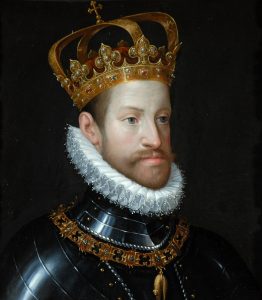Vladimir Putin may have created a new superpower — and it’s not Russia. In the weeks since Putin invaded Ukraine, the European Union has changed. A recent New York Times opinion piece suggests the invasion has both united and militarized the EU (transforming it into a far more effective partner for the U.S). Europe could become an aggressive advocate for democracy, with power to rival China’s, as well as America’s. If so, how would this third superpower operate, given the EU’s decentralized structure? Europe’s own history offers an answer. The EU starts to look like the Holy Roman Empire.
Holy Roman Giant
In 800 AD, the Pope anointed a new “Roman Emperor”: the Frankish king, Charlemagne. For the next thousand years, the Holy Roman Empire governed much of Europe, with Germany as its eventual heartland.
Some historians call the empire weak because it never centralized into a nation-state, like England, France, and Spain. Rather, the emperor ruled a vast collection of semi-independent dukedoms, bishoprics, city-states, and other realms. But can “weak” really describe a regime that lasted a thousand years?
A Different Kind of Power
The emperor did lack the centralized power wielded by nation-state kings. By the 1500s, a Western European king (or his parliament) could tax the entire realm and command essentially all its soldiers, unlike the emperor. But the Holy Roman Emperor still ruled a realm larger than any nation-state. And he could coordinate cooperative defense — and offense — by his vassal states. In fact, the emperor’s armies and those of his vassals gave Europe its primary protection against enemies from the east, including the Magyar barbarians (900s) and the Ottoman Empire (1500s-1600s).
The Holy Roman Empire also provided councils and other government structures. The member-states used those imperial agencies to cooperate on defense, trade, and other projects.
Thanks to those resources, the empire reigned as Europe’s greatest power for much of its history. And the emperor stood above other rulers as the continent’s most prestigious monarch. (See World History Encyclopedia for more on the empire.)
The New Empire
Like the Holy Roman Empire, the European Union is not a nation-state — and it doesn’t control a large part of its member-states’ revenues or military resources. But the EU can coordinate collective defense (including through NATO). And it can manage other joint projects — again, just like the empire. Since the Ukraine invasion began, the EU has used its collective military and financial power against Russia, with great effect.
The EU governs more than 445 million people. That’s more than the United States or any other nation, except China and India. And the EU’s gross domestic product exceeds $15 trillion, putting it second in the world after the U.S. ($20 trillion) and just above China (slightly less than $15 trillion). If the EU keeps asserting itself on the world stage, it could wield superpower influence.
Until the last couple centuries, no one considered the nation-state the only or even the best structure for a powerful realm. That’s a modern prejudice — one we might have to drop, if EU assertiveness and might keep rising. The European Union could revive the complex, decentralized, consensus-based power of the Holy Roman Empire.
© 2022 by David W. Tollen. All rights reserved.
Illustrations:
- Map of the Holy Roman Empire in 1356, by Cameron Pauley, provided through Wikimedia Commons and licensed under Creative Commons Attribution-Share Alike 4.0 International
- The Holy Roman Emperor Charles V , by Juan Pantoja de la Cruz (Style of)
- Imperial coat of arms, Holy Roman Empire, with the coats of arms of the prince-electors: Cologne, Mainz, Trier, Bohemia, Palatinate, Brandenburg, Saxony, from a 1545 armorial printed in Frankfurt
- The European Union after the January 2020 departure of the UK and Gibraltar, by Evan Centanni, from blank map by Ssolbergj, provided through Political Geography Now and licensed under under Creative Commons Attribution-ShareAlike 3.0 Unported





I enjoyed that. well reasoned argument.